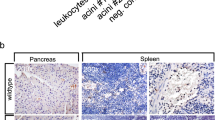Abstract
We recently found that complement C3 is locally synthesized and secreted into the exocrine pancreas. In the present study, we attempted to demonstrate the secretion of complement C4 and factor B in the exocrine pancreas. In five samples of pancreatic fluid, both C4 and factor B proteins were detected by emzyme-linked immunosorbent assay (ELISA). Immunoblot analysis revealed the C4 and factor B molecules in pancreatic fluid to be identical with these molecules in serum. Reverse transcriptase (RT)-polymerase chain reaction (PCR) analysis in pancreatic carcinoma cell lines suggested ductal epithelial cells to be the local production sites of these proteins in the pancreas. The secretion of C4 and factor B in ductal cell lines (PANC-1 and MIA PaCa-2) was independently regulated by interleukin (IL)-1β, tumor necrosis factor (TNF)-α, and interferon (IFN)-γ; C4 secretion was induced by IFN-γ, whereas factor B secretion was induced by IL-1β, TNF-α, or IFN-γ. These observations indicate that: (a) complement C4 and factor B are secreted into the exocrine pancreas, (b) ductal epithelial cells appear to be the site of C4 and factor B biosynthesis, and (c) local secretion of C4 and factor B in the pancreas is differentially regulated by IL-1β, TNF-α, and IFN-γ.
Similar content being viewed by others
References
Morgan BP. The complement system. In: Morgan BP (ed) Complement: Clinical aspects and relevance to disease. London: Academic, 1990;1–35.
Sackstein R, Colten HR. Molecular regulation of MHC Class III (C4 and factor B) gene expression in mouse peritoneal macrophages. J Immunol 1984;133:1618–1626.
Mestecky J, McGhee JR. Immunoglobulin A (IgA): Molecular and cellular interactions involved in IgA biosynthesis and immune response. Adv Immunol 1987;40:153–245.
Tourville DR, Adler RH, Bienenstock J, et al. The huam secretory immunoglobulin system: Immunohistological localization of IgA, secretory piece, and lactoferrin in normal human tissues. J Exp Med 1969;129:411–429.
Brasher GW, Dyck WP, Hall FF, et al. Immunoglobulin characterization of human pancreatic fluid. Am J Dig Dis 1975; 20:454–459.
Soto JM, Bramis J, Aufses AH, et al. The pancreas and immunoglobulins 1. Immunoglobulin levels in pancreatic secretion of patients with normal function: Preliminary studies. Am J Gastroenterol 1977;67:345–347.
Colten HR, Strunk RC. Synthesis of complement components in liver and at extrahepatic sites. In: Whaley K, Loos M, Weiler JM (eds) Complement in health and disease. Dordrecht: Kluwer, 1993:127–158.
Andoh A, Fujiyama Y, Bamba T, et al. Differential cytokine regulation of complement C3, C4, and factor B synthesis in human intestinal epithelial cell line, Caco-2. J Immunol 1993;151: 4239–4247.
Andoh A, Fujiyama Y, Sumiyoshi K, et al. Local secretion of complement component C3 in the exocrine pancreas: Ductal epithelial cells as a possible biosynthetic site. Gastroenterology 1996;110:1919–1925.
Schneiderman RD, Lint TF, Knight KL. Activation of the alternative pathway of complement by twelve different rabbitmouse chimeric transfectoma IgA isotypes. J Immunol 1990;145: 233–237.
Zhang W, Lachmann PJ. Glycosylation of IgA is required for optimal activation of alternative complement pathway by immune complexes. Immunology 1994;81:137–141.
Lieber M, Mazzetta J, Nelson-Rees W, et al. Establishment of a continuous tumor-cell line (PANC-1) from a human carcinoma of the exocrine pancreas. Int J Cancer 1975;15:741–747.
Yunis AA, Arimura GK, Russin DJ. Human pancreatic carcinoma (MIA PaCa-2) in continuous culture: Sensitivity to asparaginase. Int J Cancer 1977;19:128–135.
Yamaguchi N, Yamamura Y, Koyama K, et al. Characterization of new human pancreatic cancer cell lines which propagate in a protein-free chemically defined medium. Cancer Res 1990; 50:7008–7014.
Laemmli UK. Cleavage of structual proteins during the assembly of the head of bacteriophage T4. Nature 1970;227:680–685.
Towbin H, Staehelin T, Gordon J. Electrophoretic transfer of proteins from polyacrylamide gels to nitrocellulose sheets: Procedure and some applications. Proc Natl Acad Sci USA 1979;76:4350–4354.
Chomczynski P, Sacchi N. Single-step method of RNA isolation by acid guanidinium thiocyanate-phenol-chloroform extraction. Anal Biochem 1987;162:156–159.
Cross SJ, Edwards JH, Bentley DR, et al. DNA polymorphism of the C2 and factor B genes. Immunogenetics 1985;21:39–48.
Witte DP, Welch TR, Beischel LS. Detection and cellular localization of human C4 gene expression in the renal tubular epithelial cells and other extrahepatic epithelial sources. Am J Pathol 1991;139:717–724.
Kloppel G, Maillet B. Pathology of acute and chronic pancreatitis. Pancreas 1993;8:659–670.
Roxvall LI, Bengtson A, Heideman MI. Anaphylatoxins and terminal complement complexes in pancreatitis. Evidence of complement activation in plasma and ascites fluid of patients with acute pancreatitis. Arch Surg 1990;125:918–921.
Norman J, Franz M, Messina J, et al. Interleukin-1 receptor antagonist decreases severity of experimental acute pancreatitis. Surgery 1995;117:648–655.
Grewal HP, el Din AM, Gaber L, et al. Amelioration of the physiologic and biochemical changes of acute pancreatitis using an anti-TNF-α polyclonal antibody. Am J Surg 1994;167: 214–219.
Norman J, Franz M, Richer A, et al. Rapid elevation of systemic cytokines during acute pancreatitis and their origination within the pancreas. Surg Forum 1994;45:148–150.
Author information
Authors and Affiliations
Rights and permissions
About this article
Cite this article
Sumiyoshi, Ki., Andoh, A., Fujiyama, Y. et al. Biosynthesis and secretion of MHC class III gene products (complement C4 and factor B) in the exocrine pancreas. J Gastroenterol 32, 367–373 (1997). https://doi.org/10.1007/BF02934495
Received:
Accepted:
Issue Date:
DOI: https://doi.org/10.1007/BF02934495




